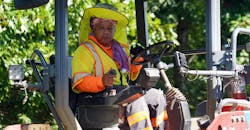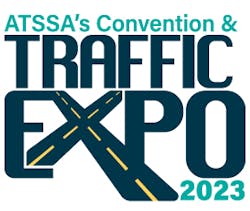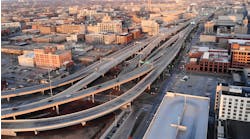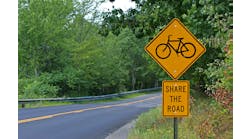Safety of the workforce is of paramount importance — yet accidents still happen. The National Work Zone Safety Information Clearinghouse reports an alarmingly consistent trend: Every year there are hundreds of work-related deaths and fatal crashes. The causes of these accidents are varied. Fatalities occur when workers on foot are struck by vehicles; while they are riding or driving in vehicles; or due to falls, being struck or trapped by objects or equipment, or electrocution.
“It’s important to remember that, at the end of the day, everyone deserves to go home to their families,” says Adam Weiser, P.E., PTOE, RSP of Whitman, Requardt & Associates, LLP, a nationally recognized engineering, architectural, construction management and environmental firm.
However, this begs the question: What’s the best way to accomplish that goal?
Buy-In Is Key
For safety measures to be effective, it must be a joint effort. Neil Boudreau, assistant administrator for traffic and safety, Massachusetts Department of Transportation (MassDOT) Highway Division, explains the challenges: “We all have standards we must follow, but standards alone are not always enough. We need to provide additional safety measures to lower the risks people working on infrastructure must face.” Safety must be a consideration not only for the workers who are on-site, but for management as well.
First and foremost, training the workforce is essential. “Employers should provide training for both new hires and seasoned employees,” Weiser notes. “Safety training is absolutely not a one-time thing. That holds true even for employees who primarily work in the office but occasionally do field work.” He recommends tailgate talks and regular safety briefings, including providing information about required personal protective equipment.
Weiser also recommends hiring a dedicated safety manager or assigning that responsibility to several highly trained individuals on the team. He suggests considering a certification requirement for certain job classifications, such as flaggers and traffic control personnel. “Trained individuals know what to look for and how to address safety concerns,” he says.
A comprehensive safety strategy also involves considering the public’s point of view. For example, Boudreau mentions that MassDOT has expanded its toolbox to include visual and physical cues to ensure that drivers are alerted to work zones — for example, installing temporary rumble strips on high-speed roadway projects ahead of lane closures to get people to slow down before they reach the work areas.
He notes that buy-in from all stakeholders is essential, adding, “Be sure to make it a point to talk with folks before implementing any changes to work area protection, and allow feedback about why something may not be working.”
However, training staff in safety practices comes with certain challenges. “Constant turnover is one of those,” says Weiser. “You need to develop a robust training program for new hires.” New, inexperienced staff may be at heightened risk for accidents because they don’t know the protocols, but even old hands need a refresher to keep them current.
Weiser also notes that because on-site staff may not have the availability to conduct periodic safety checks, it then falls to management to make time for regular site visits and work environment assessments. This not only protects the workforce — it shields an organization from risk.
It is simply not enough to talk about safety. It must be a mandate for everybody involved in a project, from the top down.
Building a Strategy
Both Boudreau and Weiser note that the ATSSA Convention & Traffic Expo has helped them develop strategies for worker safety.
Boudreau sees it as a real learning opportunity, making it a point to engage with manufacturers, suppliers and other industry professionals. Technical sessions also provide him with best practice information. He observes, “At the end of the day, if there’s a better way to do things — something that protects the men and women who maintain our infrastructure or the motorists driving through temporary traffic control zones — I want to know about it.”
Weiser serves on several committees within ATSSA and appreciates the opportunity the event affords him to learn about state-of-the-art traffic safety. “It’s a rewarding experience that allows me to apply what I learn to my day-to-day job,” he says.
“Open lines of communication go a long way toward keeping people safe,” notes Boudreau, who will be attending the expo for his fifteenth consecutive year. “Engaging with peers and industry professionals and bringing that messaging home to share with your team ensures that everybody is on the same page when it comes to safety.”
ATSSA’s 53rd Annual Convention & Traffic Expo is scheduled for February 17–23, 2023 in Phoenix and is attended by more than 3,500 manufacturers, suppliers, government agencies, legislative advocates and contractors. Mickey Riesenberg, ATSSA Director of Meetings and Convention, says, “The convention is a great forum for every aspect of the roadway safety industry. With so many industry professionals under one roof, discussion and discovery are naturally going to happen.”
She adds that the education sessions can help companies learn how to plan and manage worker safety training. The convention is also the setting where ATSSA committees meet. In particular, the Roadway Worker Protection Council focuses on mitigating risk and tragedy. “It’s a great place for an individual, company or agency to understand worker safety concerns from every angle. That leads to protection for workers from physical harm while also shielding the organization from risk,” she concludes.
To learn more about education sessions to improve worker safety, visit Expo.ATSSA.com.
Sponsored by:




